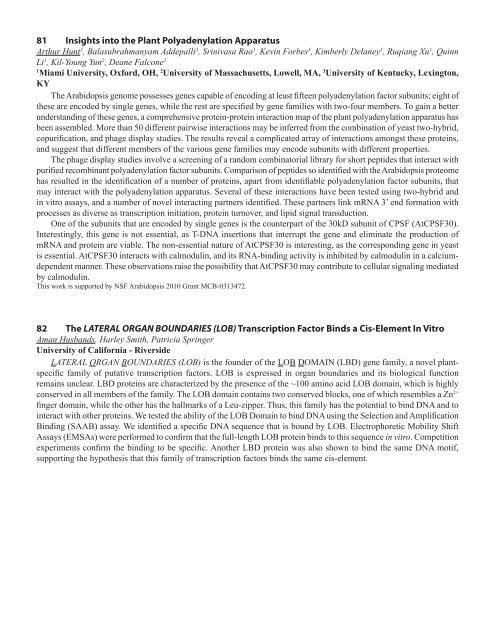75 Integrating Membrane Transport with Male Gametophyte ... - TAIR
75 Integrating Membrane Transport with Male Gametophyte ... - TAIR
75 Integrating Membrane Transport with Male Gametophyte ... - TAIR
Create successful ePaper yourself
Turn your PDF publications into a flip-book with our unique Google optimized e-Paper software.
81 Insights into the Plant Polyadenylation Apparatus<br />
Arthur Hunt 3 , Balasubrahmanyam Addepalli 3 , Srinivasa Rao 3 , Kevin Forbes 3 , Kimberly Delaney 3 , Ruqiang Xu 1 , Quinn<br />
Li 1 , Kil-Young Yun 2 , Deane Falcone 2<br />
1<br />
Miami University, Oxford, OH, 2 University of Massachusetts, Lowell, MA, 3 University of Kentucky, Lexington,<br />
KY<br />
The Arabidopsis genome possesses genes capable of encoding at least fifteen polyadenylation factor subunits; eight of<br />
these are encoded by single genes, while the rest are specified by gene families <strong>with</strong> two-four members. To gain a better<br />
understanding of these genes, a comprehensive protein-protein interaction map of the plant polyadenylation apparatus has<br />
been assembled. More than 50 different pairwise interactions may be inferred from the combination of yeast two-hybrid,<br />
copurification, and phage display studies. The results reveal a complicated array of interactions amongst these proteins,<br />
and suggest that different members of the various gene families may encode subunits <strong>with</strong> different properties.<br />
The phage display studies involve a screening of a random combinatorial library for short peptides that interact <strong>with</strong><br />
purified recombinant polyadenylation factor subunits. Comparison of peptides so identified <strong>with</strong> the Arabidopsis proteome<br />
has resulted in the identification of a number of proteins, apart from identifiable polyadenylation factor subunits, that<br />
may interact <strong>with</strong> the polyadenylation apparatus. Several of these interactions have been tested using two-hybrid and<br />
in vitro assays, and a number of novel interacting partners identified. These partners link mRNA 3’ end formation <strong>with</strong><br />
processes as diverse as transcription initiation, protein turnover, and lipid signal transduction.<br />
One of the subunits that are encoded by single genes is the counterpart of the 30kD subunit of CPSF (AtCPSF30).<br />
Interestingly, this gene is not essential, as T-DNA insertions that interrupt the gene and eliminate the production of<br />
mRNA and protein are viable. The non-essential nature of AtCPSF30 is interesting, as the corresponding gene in yeast<br />
is essential. AtCPSF30 interacts <strong>with</strong> calmodulin, and its RNA-binding activity is inhibited by calmodulin in a calciumdependent<br />
manner. These observations raise the possibility that AtCPSF30 may contribute to cellular signaling mediated<br />
by calmodulin.<br />
This work is supported by NSF Arabidopsis 2010 Grant MCB-0313472.<br />
82 The LATERAL ORGAN BOUNDARIES (LOB) Transcription Factor Binds a Cis-Element In Vitro<br />
Aman Husbands, Harley Smith, Patricia Springer<br />
University of California - Riverside<br />
LATERAL ORGAN BOUNDARIES (LOB) is the founder of the LOB DOMAIN (LBD) gene family, a novel plantspecific<br />
family of putative transcription factors. LOB is expressed in organ boundaries and its biological function<br />
remains unclear. LBD proteins are characterized by the presence of the ~100 amino acid LOB domain, which is highly<br />
conserved in all members of the family. The LOB domain contains two conserved blocks, one of which resembles a Zn 2+<br />
finger domain, while the other has the hallmarks of a Leu-zipper. Thus, this family has the potential to bind DNA and to<br />
interact <strong>with</strong> other proteins. We tested the ability of the LOB Domain to bind DNA using the Selection and Amplification<br />
Binding (SAAB) assay. We identified a specific DNA sequence that is bound by LOB. Electrophoretic Mobility Shift<br />
Assays (EMSAs) were performed to confirm that the full-length LOB protein binds to this sequence in vitro. Competition<br />
experiments confirm the binding to be specific. Another LBD protein was also shown to bind the same DNA motif,<br />
supporting the hypothesis that this family of transcription factors binds the same cis-element.





